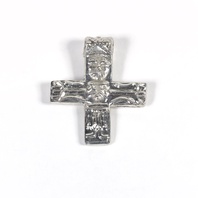
Viking Objects
Reproduction Crucifix Pendant
Crucifixes like this one would have been worn to display one’s faith and may have been a way for newly converted Scandinavians to be more accepted in society. By the late tenth to early eleventh centuries, assimilation would have seen many Scandinavians, both elites and common people, converted to Christianity and adopting Anglo-Saxon ways.
Read More
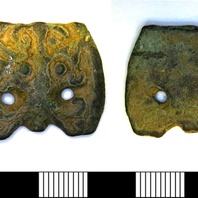
Viking Objects
Stirrup-Strap Mount (LEIC-7584A4)
This incomplete example of an Anglo-Scandinavian copper alloy stirrup-strap mount has the form of a Williams Class A mount and its decoration is similar to type 4.
Read More
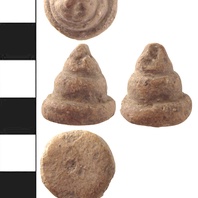
Viking Objects
Cast Lead Weight (SWYOR-A48576)
A cast lead-alloy weight or possible gaming piece in the form of a cone made of three levels. It is perhaps an indicator of the Scandinavian bullion economy. Weights are an important form of evidence for Viking Age commerce and the use of standards across the different economic systems within which Vikings were integrated. Many of the weights discovered, particularly ones in Ireland and those of Arabic type, suggest that a standardized system of weights existed in some areas. These standard weights, alongside standard values of silver, are what allowed the bullion economy of Viking occupied areas to function. A bullion economy was a barter economy that relied on the exchange of set amounts of precious metal in various forms, such as arm-rings or coins, for tradable goods, such as food or textiles. Each merchant would have brought their own set of weights and scales to a transaction to make sure that the trade was conducted fairly.
Read More
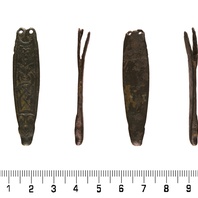
Viking Objects
Decorated Strap-End (WMID-2D6997)
A copper-alloy Thomas Class A Type 1 strap-end with a section at the top which splits into a ‘V’ shape. The strap-end is decorated with what seems to be a stylized face above some interlaced knotwork while the tip features a stylized beast head.
Read More
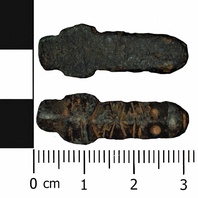
Viking Objects
Zoomorphic Strap-End (LANCUM-E11AB2)
This Thomas Class B, Type 4 strap-end has a pointed zoomorphic terminal moulded to represent an animal head with large semi-circular eyes and ears in Trewhiddle style. There are possible traces of niello in the recesses. .
Read More
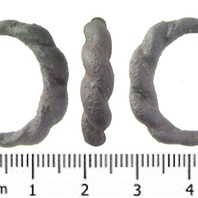
Viking Objects
Copper-Alloy Finger-Ring (SWYOR-AA27B1)
This copper-alloy finger-ring seems as if it was made from two strands of twisted wire, but could possibly have been cast. The ropework hoop may have been gilded. Even though similar designs are known from the Viking period, they were also used in other periods as well. Hence, the large date range.
Read More
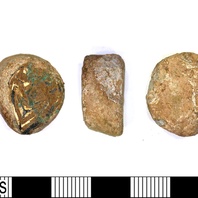
Viking Objects
Gilded Lead-Alloy Weight (LEIC-C6C96A)
The inset decoration of this weight is probably a reused fragment of an Irish or Anglo-Saxon object. Its importation and re-working is likely the result of Viking intervention. The distinction of weights by embedded objects or other embellishments in various media is a widely recognised feature of some early medieval weights. Weights are an important form of evidence for Viking Age commerce and the use of standards across the different economic systems within which Vikings were integrated. Many of the weights discovered, particularly ones in Ireland and those of Arabic type, suggest that a standardized system of weights existed in some areas. These standard weights, alongside standard values of silver, are what allowed the bullion economy of Viking-occupied areas to function. A bullion economy was a barter economy that relied on the exchange of set amounts of precious metal in various forms, such as arm-rings or coins, for tradeable goods, such as food or textiles. Each merchant would have brought their own set of weights and scales to a transaction to make sure that the trade was conducted fairly.
Read More
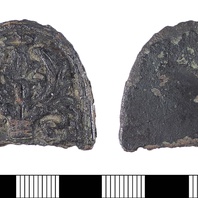
Viking Objects
Carolingian-Style Strap-End (LIN-9A2879)
It has been suggested this this strap-end came from a sword harness and, therefore, is classed as Thomas’s Class E, Type 1. The strap-end bears Carolingian-style relief decoration of a palmette set within a stylised plant with acanthus foliage and brush-like leaves. It does now show any evidence of gilding. Carolingian belt fittings from England could have been imported either indirectly through Scandinavia or directly from the Continent. It is possible that this strap end was brought over by Scandinavians as a result of their raids on the continent. Gabor Thomas suggests that the localisation of similar types of strap ends, known as Aspatria-type, in the Irish Sea region could indicate that they were worn by Scandinavian communities in that area.
Read More
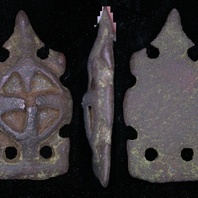
Viking Objects
Copper-Alloy Strap-End (LEIC-982247)
This Anglo-Scandinavian copper-alloy strap-end is decorated with a sub-circular dome which is flanked by eight circular holes joined into pairs by a recessed channel creating a raised ‘cross’. There are very faint traces of possible ring and dot motifs on the surface of the cross. It has been classified as a Thomas Class E.
Read More
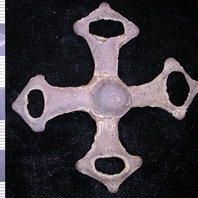
Viking Objects
Harness Strap-Divider (LEIC-0DF1A3)
This harness strap-divider is cross-shaped with a central domed boss. The loops would have held leather harness straps and were usually placed at the side of a horse’s head.
